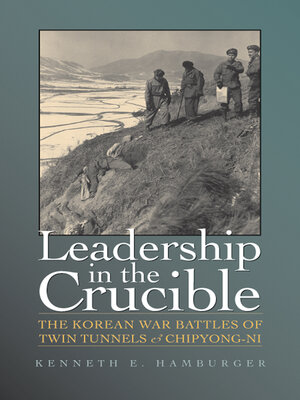Leadership in the Crucible
ebook ∣ The Korean War Battles of Twin Tunnels and Chipyong-ni · Williams-Ford Texas A&M University Military History Series
By Kenneth E. Hamburger

Sign up to save your library
With an OverDrive account, you can save your favorite libraries for at-a-glance information about availability. Find out more about OverDrive accounts.
Find this title in Libby, the library reading app by OverDrive.



Search for a digital library with this title
Title found at these libraries:
| Library Name | Distance |
|---|---|
| Loading... |
At the pivotal battles of Twin Tunnels and Chipyong-ni in February 1951, U.N. forces met and contained large-scale attacks by Chinese forces. Colonel Paul Freeman and the larger-than-life Colonel Ralph Monclar led the American 23rd Infantry Regiment and the French Bataillon de Corée, respectively, in the fierce and dangerous battles that followed the precipitous U.N. retreat down the Korean Peninsula.
In Leadership in the Crucible, Kenneth Hamburger details the actions of the units in the United Nations counteroffensive following the Chinese intervention, including routine patrols, the harrowing battle of Twin Tunnels, and the pivotal siege of Chipyong-ni. The regiment was cut off from artillery fire support and was resupplied only by parachute drops. Repeatedly attacked by superior Chinese forces during the two nights and final day of fighting, the U.N. units finally welcomed relief by the armored Tank Force Crombez of the 1st Cavalry Division.
From extensive personal interviews and a careful reconstruction of the written record, Hamburger brilliantly analyzes the roles that training, cohesion, morale, logistics, and leadership play in success or failure on the front lines of limited war. He also addresses the vexing problem of when, and at what level, commanders have the right and even the responsibility to question lawful orders they believe are flawed.
In this careful consideration of combat leadership at all levels, Hamburger offers his readers stories of men sustaining themselves and one another to the limits of human endurance. By thoroughly sorting out the chaos, carnage, and courage of the battles, he provides a uniquely detailed description of these two crucial battles and a well-organized discussion of unit cohesion and command that is sure to become a classic in the field of leadership studies.
In Leadership in the Crucible, Kenneth Hamburger details the actions of the units in the United Nations counteroffensive following the Chinese intervention, including routine patrols, the harrowing battle of Twin Tunnels, and the pivotal siege of Chipyong-ni. The regiment was cut off from artillery fire support and was resupplied only by parachute drops. Repeatedly attacked by superior Chinese forces during the two nights and final day of fighting, the U.N. units finally welcomed relief by the armored Tank Force Crombez of the 1st Cavalry Division.
From extensive personal interviews and a careful reconstruction of the written record, Hamburger brilliantly analyzes the roles that training, cohesion, morale, logistics, and leadership play in success or failure on the front lines of limited war. He also addresses the vexing problem of when, and at what level, commanders have the right and even the responsibility to question lawful orders they believe are flawed.
In this careful consideration of combat leadership at all levels, Hamburger offers his readers stories of men sustaining themselves and one another to the limits of human endurance. By thoroughly sorting out the chaos, carnage, and courage of the battles, he provides a uniquely detailed description of these two crucial battles and a well-organized discussion of unit cohesion and command that is sure to become a classic in the field of leadership studies.







